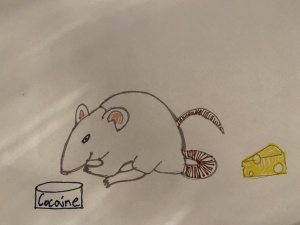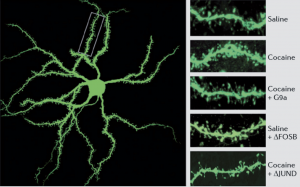Cocaine is one of, if not, the most prolific drug of the last 50 years. It is extracted from the leaves of cocoa plants by multiple acid base and other redox reactions. Cocaine was originally synthesized in the year of 1859 by the chemist Albert Neiman. However recently, its wide spread recreational use wasn’t popularized until the 1970’s in America. While it was a part of American culture in the early 20th century it wasn’t widely available until Columbian drug cartels began shipping massive amounts. With over 70 billion dollars of cocaine on the street there are approximately 20 million users across the world.
How does Cocaine work?
In the short-term cocaine works by inhibiting the reuptake of dopamine specifically in the Nucleus accumbens of the brain. This is the region of the brain that regulates our reward feelings. When we are hungry and eat, or are thirsty and drink, the sense of relief and reward on3 experiences is caused by dopaminergic cells flooding the nucleus accumbens with dopamine. This good feeling makes us want to eat and drink again, keeping us alive. The artificial accumulation of dopamine in this region of the brain gives us an exaggerated feeling of reward and drives us to need cocaine in the same way we need food. In fact, when mice are given the option of cocaine or food many will choose cocaine to and past the point of starving to death.

Cocaine and Addiction
Dopamine however has a relatively short life in the synapses of the brain’s neurons, giving a high that rarely last longer than a few hours. The long-term addiction affects must be explained by another mechanism in the brain. Addiction and its affects are caused by changes in the expression of certain genes. One particular transcription factor cocaine influence is ΔFosB. “Researchers believe ΔFosB may constitute an important molecular “switch” in the transition from drug abuse to addiction.” ΔFosB lasts for up to 8 weeks before it breaks down causing it to accumulate in repeated cocaine use. Mice with increased levels of ΔFosB have shown addictive behaviors even when not exposed to a drug. However, addiction lasts much longer than 8 weeks, research shows ΔFosB is still to blame.
How does ΔFosB work?
Chronic cocaine exposure causes nerve cells in the nucleus accumbens to extend and sprout new offshoots on their dendrites. This growth is caused by an accumulation of the transcription factor ΔFosB. These dendrite growths cause the nucleus acccumbens to pick up more signaling from other parts of the brain which may explain the very long-lived behavioral changes associated with addiction. “For example, enhanced inputs from the hippocampus and amygdala could be responsible for the intense craving that occurs when drug-associated memories are stimulated.”
This picture shows dendrite growth in different mouse brains with long term exposure to a variable. Saline shows baseline growth and cocaine is shown in comparison. Cocaine paired with ΔFosB inhibitors (G9a and JUND) show very little extra dendrite growth. Saline with artificially elevated ΔFosB showed more dendrite growth then the baseline.

